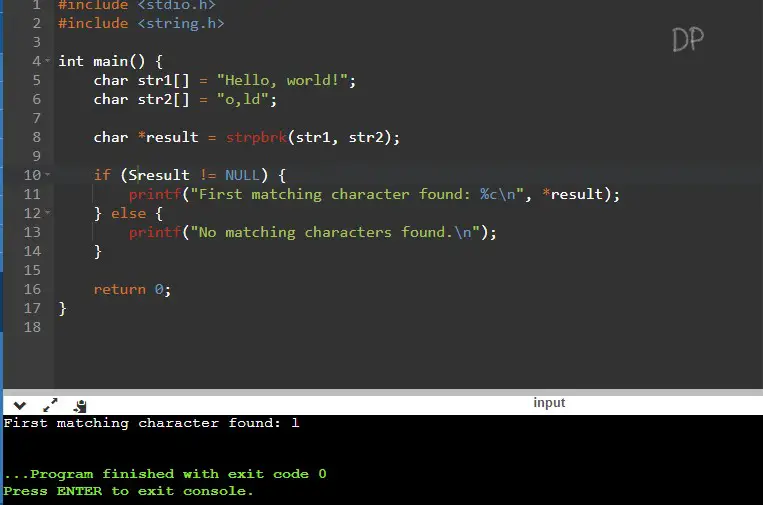The strpbrk() function is a standard library function in the C programming language that is used to search for the first occurrence of any character from a given set of characters in a string. It is declared in the <string.h> header file.
The function signature of strpbrk() is:
char *strpbrk(const char *str1, const char *str2);
Here, str1 is the string in which the search is performed, and str2 is the set of characters to be matched. The function returns a pointer to the first occurrence of any character from str2 in str1 or NULL if no matching characters are found.
The strpbrk() function performs a linear search through str1, examining each character one by one. It compares each character in str1 with each character in str2 until a match is found. If a match is found, the function returns a pointer to the matching character in str1. The search stops as soon as a match is found, so it does not necessarily return the first occurrence of the first character in str2.
The strpbrk() function is useful when you want to determine if a string contains any of the characters from a given set of characters. It provides a simple way to search for a group of characters within a string and can be used in various applications, such as string manipulation, parsing, and pattern matching.
Problem statement
You are given two strings, str1 and str2. Your task is to implement the strpbrk() function, which searches str1 for the first occurrence of any character from str2 and returns a pointer to the matching character in str1. If no matching characters are found, the function should return NULL.
Write a C function with the following signature:
Input:
- The function takes two arguments:
str1(const char*): A null-terminated string in which the search is performed.str2(const char*): A null-terminated string containing the set of characters to be matched.
Output:
- The function should return a pointer to the first occurrence of any character from
str2instr1, orNULLif no matching characters are found.
Constraints:
- The input strings
str1andstr2consist of printable ASCII characters (excluding null characters). - The length of
str1andstr2is at most 10^5.
Note:
- The search should stop as soon as a matching character is found. The returned pointer should point to the first matching character in
str1. - If
str1orstr2is an empty string (length 0), the function should returnNULL. - If
str1isNULLorstr2isNULL, the function should returnNULL.
Implement the strpbrk() function and write a sample C program to demonstrate its usage
C Program to Implement strpbrk() Function
#include <stdio.h>
#include <string.h>
int main() {
char str1[] = "Hello, world!";
char str2[] = "o,ld";
char *result = strpbrk(str1, str2);
if (result != NULL) {
printf("First matching character found: %c\n", *result);
} else {
printf("No matching characters found.\n");
}
return 0;
}
How it Works?
The strpbrk() function works by performing a linear search through the string str1 and comparing each character with each character in the string str2. Here’s how the function works:
- The function takes two arguments:
str1andstr2. - It initializes two pointers:
p1pointing to the start ofstr1, andp2that will be used for iterating throughstr2. - The function enters a loop that continues until the end of
str1is reached (i.e., until the character pointed byp1is not null). - Inside the loop, the function enters another loop that iterates through each character of
str2. It starts by pointingp2to the start ofstr2. - It compares the character pointed by
p1with the character pointed byp2. If they match, it means a matching character is found. - If a match is found, the function returns a pointer to the matching character in
str1, which is(char *)p1. - If no match is found, the inner loop continues by incrementing
p2to the next character instr2. If there are more characters instr2, the inner loop continues to the next iteration, comparing the character pointed byp1with the next character instr2. - If the inner loop finishes without finding a match, the outer loop continues by incrementing
p1to the next character instr1. It then repeats the inner loop to search for a matching character with the next character instr1. - If the outer loop finishes without finding a match, it means no matching characters were found in
str1. In this case, the function returnsNULL. - The calling function can check the return value of
strpbrk()to determine if any matching characters were found. If the return value isNULL, it means no matches were found. Otherwise, it points to the first matching character instr1.
Note: The function stops as soon as it finds a matching character and returns the pointer to that character. It does not necessarily return the first occurrence of the first character in str2
Input / Output




